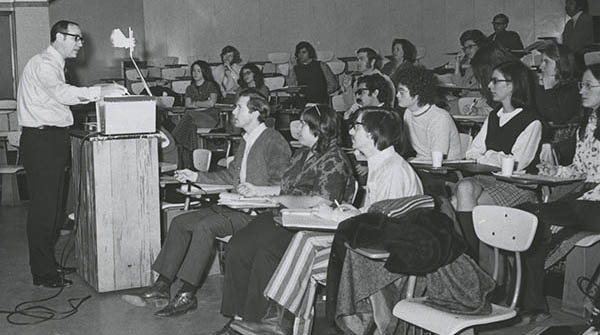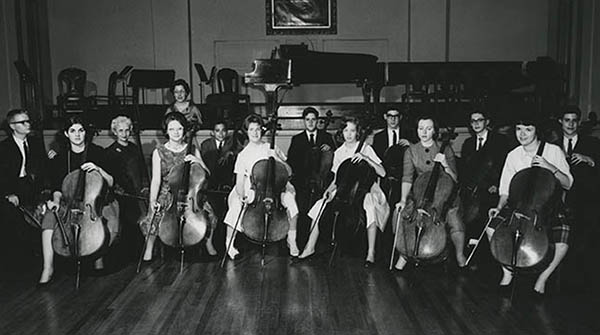
Cornelius Vanderbilt, known as "the Commodore," was in his 79th year when he decided to make the gift that founded Vanderbilt University in the spring of 1873.
The $1 million that he gave to endow and build the university was Vanderbilt's only major philanthropy. Methodist Bishop Holland N. McTyeire of Nashville, husband of Amelia Townsend who was a cousin of Vanderbilt's young second wife Frank Crawford, went to New York for medical treatment early in 1873 and spent time recovering in the Vanderbilt mansion. He won the Vanderbilts' admiration and support for the project of building a university in the South that would "contribute to strengthening the ties which should exist between all sections of our common country."
McTyeire chose the site for the campus, supervised the construction of buildings and personally planted many of the trees that today make Vanderbilt a national arboretum. At the outset, the university consisted of one Main Building (now Kirkland Hall), an astronomical observatory and houses for professors. Landon C. Garland was Vanderbilt's first chancellor, serving from 1875 to 1893. He advised McTyeire in selecting the faculty, arranged the curriculum and set the policies of the university.


For the first 40 years of its existence, Vanderbilt was under the auspices of the Methodist Episcopal Church, South. The Vanderbilt Board of Trust severed its ties with the church in June 1914 as a result of a dispute with the bishops over who would appoint university trustees.
From the outset, Vanderbilt met two definitions of a university: It offered work in the liberal arts and sciences beyond the baccalaureate degree and it embraced several professional schools in addition to its college. James H. Kirkland, the longest serving chancellor in university history (1893-1937), followed Chancellor Garland. He guided Vanderbilt to rebuild after a fire in 1905 that consumed the main building, which was renamed in Kirkland's honor, and all its contents. He also navigated the university through the separation from the Methodist Church. Notable advances in graduate studies were made under the third chancellor, Oliver Cromwell Carmichael (1937-46). He also created the Joint University Library, brought about by a coalition of Vanderbilt, Peabody College and Scarritt College.
Vanderbilt's student enrollment tended to double itself each 25 years during the first century of the university's history: 307 in the fall of 1875; 754 in 1900; 1,377 in 1925; 3,529 in 1950; 7,034 in 1975. In the fall of 1999 the enrollment was 10,127.
In the planning of Vanderbilt, the assumption seemed to be that it would be an all-male institution. Yet the board never enacted rules prohibiting women. At least one woman attended Vanderbilt classes every year from 1875 on. Most came to classes by courtesy of professors or as special or irregular (non-degree) students.
From 1892 to 1901 women at Vanderbilt gained full legal equality except in one respect -- access to dorms. In 1894 the faculty and board allowed women to compete for academic prizes. By 1897, four or five women entered with each freshman class. By 1913 the student body contained 78 women, or just more than 20 percent of the academic enrollment.
National recognition of the university's status came in 1949 with election of Vanderbilt to membership in the select Association of American Universities. In the 1950s Vanderbilt began to outgrow its provincial roots and to measure its achievements by national standards under the leadership of Chancellor Harvie Branscomb. By its 90th anniversary in 1963, Vanderbilt for the first time ranked in the top 20 private universities in the United States.


Vanderbilt continued to excel in research, and the number of university buildings more than doubled under the leadership of Chancellors Alexander Heard (1963-1982) and Joe B. Wyatt (1982-2000), only the fifth and sixth chancellors in Vanderbilt's long and distinguished history. Heard added three schools (Blair, the Owen Graduate School of Management and Peabody College) to the seven already existing and constructed three dozen buildings. During Wyatt's tenure, Vanderbilt acquired or built one-third of the campus buildings and made great strides in diversity, volunteerism and technology.
The university grew and changed significantly under its seventh chancellor, Gordon Gee, who served from 2000 to 2007. Vanderbilt led the country in the rate of growth for academic research funding, which increased to more than $450 million and became one of the most selective undergraduate institutions in the country.
Nicholas S. Zeppos was named Vanderbilt's eighth chancellor in 2008: a year of economic calamity from which the university emerged relatively unscathed. That same year, as a mark of the university’s commitment to positive change, Zeppos implemented Opportunity Vanderbilt—a pioneering initiative that would fund loan-free tuition for the nation’s most deserving students, regardless of their background or financial means. Zeppos’ tenure was also defined by the opening of Martha Ingram Commons, a living-learning residential hall that marked the beginning of Vanderbilt’s robust and enduring Residential College system, and the launch of FutureVU, the long-term campus development plan that aims to align Vanderbilt’s physical spaces with its academic mission. He also oversaw the separation of Vanderbilt University and Vanderbilt Medical Center in 2016, a prescient decision that positioned both institutions for long-term success and independence.


Daniel Diermeier, an internationally renowned scholar of political science and managerial leadership, began his tenure as the ninth chancellor of Vanderbilt University on July 1, 2020. Formerly provost and dean of the Harris School of Public Policy at the University of Chicago, and a longtime professor at Stanford University and Northwestern University’s Kellogg School of Management, Diermeier was selected by the Vanderbilt Board of Trust after an extensive worldwide search.
Diermeier guided the university through the many challenges and unknowns of the COVID-19 pandemic—driven by Vanderbilt’s commitment to protecting the health, safety and wellbeing of the community, and also by the university’s mission to provide an empowering residential education to the leaders of tomorrow.
During his first year in office, Diermeier launched several ambitious programs with the goal of setting new benchmarks for excellence. Key initiatives include Destination Vanderbilt, a bold commitment to recruiting and hiring renowned faculty at an increased rate, and The Vanderbilt Project on Unity and American Democracy, which seeks to elevate evidence-based reasoning in the national conversation. Diermeier also oversaw the launch of Vandy United, a $300 million campaign dedicated to Vanderbilt student-athletes, athletics programs and Commodore fans, which is the largest undertaking of its kind in the university’s history.
Today, Vanderbilt University is a private research university with approximately 6,900 undergraduates and more than 6,200 graduate and professional students. Comprised of 10 distinct schools and colleges on one centralized campus in downtown Nashville, Vanderbilt spurs—and is optimized for—cross-disciplinary research, fostering discoveries that impact society for the better.
Cutting-edge, cross-disciplinary research and liberal arts, combined with strong ties to a distinguished medical center, create an invigorating atmosphere where students tailor their education to meet their goals and researchers collaborate to solve complex questions affecting our health, culture and society.
Vanderbilt, an independent, privately supported university, and the separate, non-profit Vanderbilt University Medical Center share a respected name and enjoy close collaboration through education and research. Together, the number of people employed by these two organizations exceeds that of the largest private employer in the Middle Tennessee region.